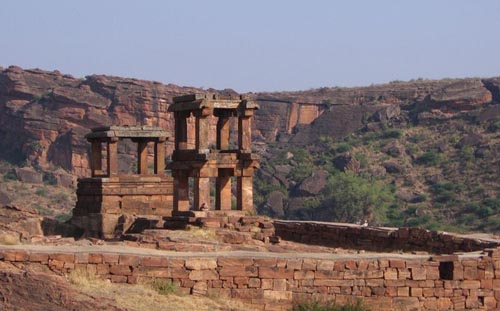Badami Fort

Information on Badami Fort (Bagalkot, Karnataka) - History & Architecture
The Badami North Fort is situated in the district of Bagalkot, North Karnataka. Badami is a small town which was previously referred to as Vatapi. It used to be the royal capital city of the Badami Chalukya rulers from the period of 540 to 757 A.D. The town is renowned for its rich historical monuments as well as beauty. The Badami North Fort which is situated in the town is amongst the most reputed archaeological places in Badami that is rich in terms of history related to the Pallavas and Chalukyas.
Badami Fort Architecture
The fort is situated on the eastern part of the Bhuthnatha temple on the summit of a cliff and just opposite to the eminent cave temples of Badami. The entrance of the mentioned fort is observed to be watched over by the Nandi, bull of Shiva. The fort is believed to be wrapped up with respect to ancient culture and grandeur dating back to the pre-historic period. The beautiful fort is found to be stretched across two mountains and is further separated into North as well as South Fort. The fort is known to include a mosque and a temple as well within its premises and presently only includes few scattered temples. An archaeological museum is situated just at the entrance of the fort which houses excellent artefacts with regard to local sculptures. After entering the fort, a route leads to the Bhuthnatha Temple Complex. The temples here are found to be positioned through the border of the nearby serene lake. The temples were constructed during the 5th century and are dedicated to Lord Shiva who is revered as the supreme lord of the five different elements or constituents also known as the bhuthaas.
Badami Fort History
The Badami North Fort is considered to be the principal fort situated on the northern part of the Agasthya Lake. The North Fort is believed to have been the place for storing the treasures of Tipu Sultan. The steps, which go ahead to the area of the forts, are found to be quite sharp along with being laborious at the same time and thus, great precaution needs to be taken while climbing the flight of those stairs. This ancient Badami North Fort was constructed by Pulakeshi, the Chalukyan King in the year 543 A.D. The two 'Shivalayas' inside the fort premises are supposed to have been constructed by King Pulakeshi II. The Upper Shivalaya was dedicated to Lord Vishnu and the Lower Shivalaya was dedicated to Ganesha. The complete wall of the Shivalaya is full of illustrations of legendary tales coupled with displays of magnificent carvings of horses as well as elephants. A watch tower forms a part of the Lower Shivalaya and is learnt to have been constructed during the 14th century. The interiors of the fort include treasure places and granaries that are worth watching as it offers a brief insight into the illustrious and renowned days of Indian history. A canon of 16th century can also be spotted towards the north side of the Lower Shivalaya. The North Badami Fort was raided and obliterated in the year 642 A.D. by the Pallavas and presently the gate and the walls of the fort are possibly the sole traces of the formerly magnificent architecture.
Badami Fort Tourism Importance
The fort stands in a desolated area presently and the steep steps make it a less opted destination. However, numerous tourists are found to visit the fort owing to its rich historical records and appealing surroundings.
- Bangalore Monuments
- Bagalkot Monuments
- Belgaum Monuments
- Bellary Monuments
- Bidar Monuments
- Bijapur Monuments
- Chitradurga Monuments
- Coorg Monuments
- Dakshina Kannada Monuments
- Gadag Monuments
- Gulbarga Monuments
- Hassan Monuments
- Mysore Monuments
- Raichur Monuments
- Uttara Kannada Monuments
- Yadgir Monuments
- Andaman Nicobar Monuments
- Andhra Pradesh Monuments
- Assam Monuments
- Bihar Monuments
- Chhattisgarh Monuments
- New Delhi Monuments
- Goa Monuments
- Gujarat Monuments
- Haryana Monuments
- Himachal Pradesh Monuments
- Jammu and Kashmir Monuments
- Karnataka Monuments
- Kerala Monuments
- Madhya Pradesh Monuments
- Maharashtra Monuments
- Odisha Monuments
- Punjab Monuments
- Rajasthan Monuments
- Tamil Nadu Monuments
- Telangana Monuments
- Uttar Pradesh Monuments
- West Bengal Monuments